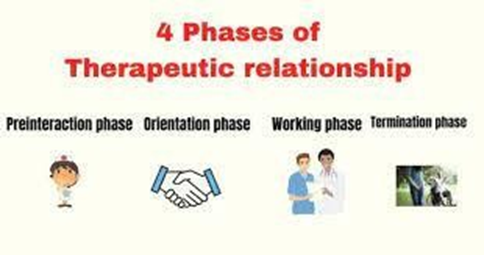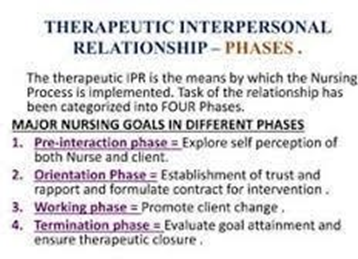During which phase of the therapeutic relationship do the caregiver and the client identify themselves by introducing themselves to one another?
Preparation phase
Orientation phase
Termination phase
Working phase
The Correct Answer is B
Choice A rationale: this is the phase where the caregiver and client establish a rapport by introducing themselves while clarifying their roles and expectations. The caregiver also explains the purpose, scope, and limits of the services they provide.
Choice B rationale: the preparation phase occurs before the client and the caregiver meet and involves the care provider reviewing the client’s information, identifying their needs, and planning for their first contact.
Choice C rationale: This is the phase where the caregiver and the client end the therapeutic relationship, evaluate the outcomes, and plan for follow-up or referral.
Choice D rationale: this phase involves the caregiver and the client implementing interventions, monitoring their progress, and modifying their goals as needed to achieve their set objectives.


Nursing Test Bank
Naxlex Comprehensive Predictor Exams
Related Questions
Correct Answer is C
Explanation
Choice A rationale: High temperatures do not usually cause people to become calm unless they are suffering from heat exhaustion or heat stroke, which are medical emergencies.
Choice B rationale: depression is usually associated with low temperatures and reduced sunlight exposure rather than high temperatures.
Choice C rationale: high temperatures is associated with arousal and agitation in some individuals which may be due to the effects of heat on the individual’s nervous system, cardiovascular, and endocrine systems.
Choice D rationale: confusion is not usually associated with confusion. However, it may result in confusion in older adults and individuals with other underlying conditions.
Correct Answer is ["0.5"]
Explanation
Dosage of the medication =the desired dose/dose at hand X the amount to be administered
= 1mg/2mg x 1 ml
= 0.5 ml
Whether you are a student looking to ace your exams or a practicing nurse seeking to enhance your expertise , our nursing education contents will empower you with the confidence and competence to make a difference in the lives of patients and become a respected leader in the healthcare field.
Visit Naxlex, invest in your future and unlock endless possibilities with our unparalleled nursing education contents today
Report Wrong Answer on the Current Question
Do you disagree with the answer? If yes, what is your expected answer? Explain.
Kindly be descriptive with the issue you are facing.
